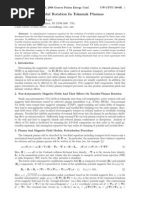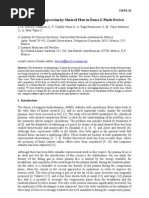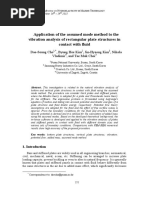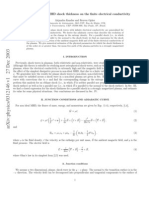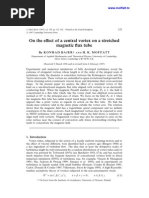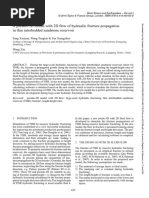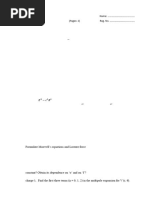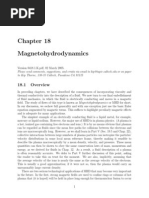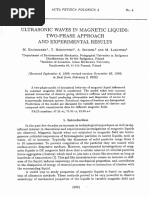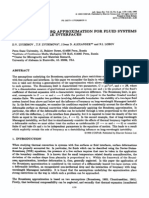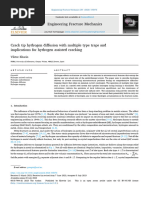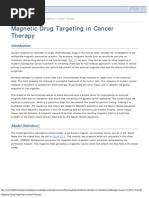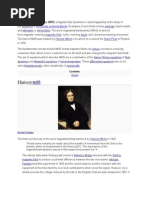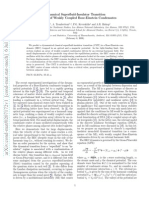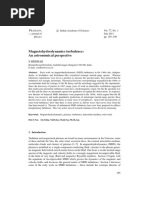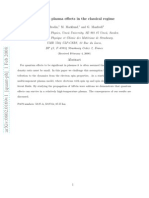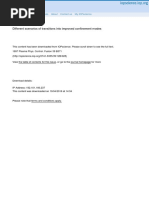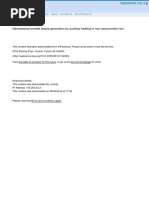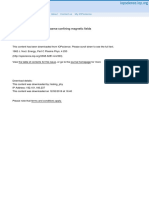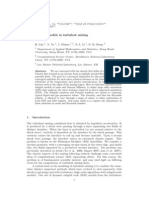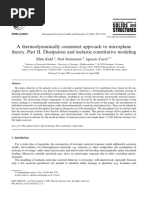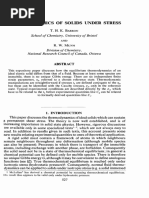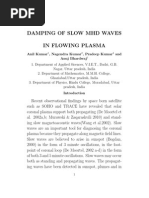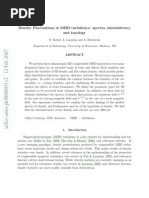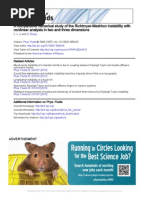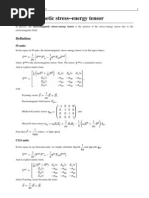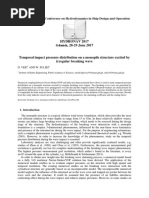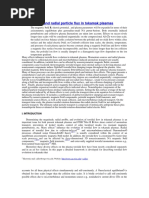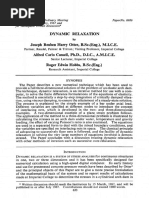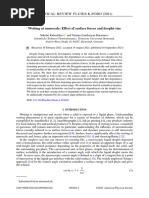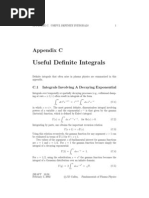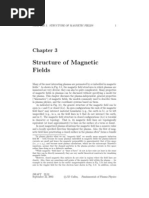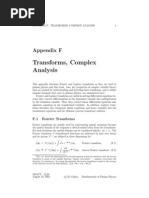Viscous Forces Due To Collisional Parallel Stresses For Extended MHD Codes
Viscous Forces Due To Collisional Parallel Stresses For Extended MHD Codes
Uploaded by
maximilianodemasiCopyright:
Available Formats
Viscous Forces Due To Collisional Parallel Stresses For Extended MHD Codes
Viscous Forces Due To Collisional Parallel Stresses For Extended MHD Codes
Uploaded by
maximilianodemasiOriginal Title
Copyright
Available Formats
Share this document
Did you find this document useful?
Is this content inappropriate?
Copyright:
Available Formats
Viscous Forces Due To Collisional Parallel Stresses For Extended MHD Codes
Viscous Forces Due To Collisional Parallel Stresses For Extended MHD Codes
Uploaded by
maximilianodemasiCopyright:
Available Formats
UW-CPTC 09-6R
Viscous Forces Due To Collisional Parallel Stresses
For Extended MHD Codes
J.D. Callen
University of Wisconsin, Madison, WI 53706-1609
(Dated: February 4, 2010)
Abstract
Various forms of the viscous force caused by collision-induced parallel viscous stresses within
an inhomogeneous magnetized plasma are presented. New forms are proposed for initial value
extended MHD codes to capture the fast (Braginskii) collisional viscous force eects on short
time scales and multi-collisionality regime residual viscous forces on collision time scales and
longer in axisymmetric toroidal plasmas. Collision-based viscosity coecients are described in
various collisionality regimes: high (Braginskii, Prsch-Schl uter), intermediate (plateau) and low
(banana). Smoothed formulas for the residual viscous forces induced by electron and ion parallel
stresses on the collision and longer time scales that encompass all these collisionality regimes are
presented. Also, a generalized Ohms law that includes both the fast Braginskii-type viscous eects
and the slow residual eects that lead to the neoclassical parallel Ohms law is proposed. Finally,
suggestions are made for implementing and verifying viscous force eects in extended MHD codes.
callen@engr.wisc.edu; http://www.cae.wisc.edu/
~
callen
1
I. INTRODUCTION
Extended magnetohydrodynamic (MHD) models used in the CEMM project [1] seek to in-
clude all relevant physics needed for simulating uid-type behavior of magnetically-conned
toroidal plasmas. The M3D [2] and NIMROD [3] code projects under the CEMM umbrella
have historically focused on using ideal and resistive MHD descriptions of axisymmetric equi-
librium toroidal plasmas. Recently, two-uid eects (e.g., diamagnetic ows, gyroviscosity)
have been included. And explorations of plasma ows and their eects have begun.
In order to properly describe the evolution of ows, the anisotropic nature of the viscous
force in a magnetized plasma needs to be taken into account. In particular, the viscous forces
induced by collision-induced parallel stresses in the plasma need to be taken into account
because: 1) they are the largest viscous forces; 2) they collisionally relax the electron and ion
ows on their respective time scales; 3) in low collisionality plasmas they lead to important
eects in the parallel neoclassical Ohms law (trapped particle eects on the resistivity and
bootstrap current) and the poloidal plasma ow (relaxation to an ion-temperature-gradient-
determined value); and 4) it is important for numerical stability and convergence issues to
properly treat dissipative eects in the M3D and NIMROD codes.
This report is organized as follows. Section II describes the parallel, cross and perpendic-
ular stresses and in particular the collisional parallel viscous stresses in a magnetized plasma.
Appendix A describes the collisional (Braginskii) parallel stresses in plasmas containing, as
is typical in tokamaks, electrons, hydrogenic ions and impurity ions. The following section
(III) presents various forms of parallel stresses and the resultant viscous forces. Thereafter,
Section IV proposes specic forms for a combination of fast Braginskii-type and resid-
ual long-time-scale viscous forces induced by parallel stresses for inclusion in the M3D
and NIMROD codes. Asymptotic residual parallel viscous force coecients in high (Bra-
ginskii, Prsch-Schl uter), intermediate (plateau) and low (banana) collisionality regimes,
and smoothed multi-collisionality formulas for electrons, hydrogenic and impurity ions are
presented in Appendix B. Their eects are developed in Appendix C. The penultimate (V)
section suggests verication tests of these viscous forces and their eects in the M3D and
NIMROD codes. The ion viscous stresses and general Ohms law in multi-collisionality
regimes for tokamak plasmas that are suggested for use in extended MHD codes are sum-
marized in Section VI. It also discusses possible limitations of the suggested forms.
2
II. COLLISIONAL STRESSES IN A MAGNETIZED PLASMA
The uid-based viscous force density on a small volume of a plasma species is . The
fact that this force density is a local dierential of the local viscous stress tensor implies
that the physical processes that cause it are also local. This is unfortunately not true in low
collisionality toroidal plasmas where the collision length v
T
/ is usually many times
the toroidal circumference of the experimental device. Nonetheless, the following discussion
and analysis seeks to capture the most important low collisionality physics within this local
model of viscous forces to facilitate inclusion of viscous force eects of parallel viscous
stresses in the M3D and NIMROD extended-MHD-based initial value codes.
The collisional Braginskii [4] viscous stress tensors are given by
=
, parallel, cross (gyroviscous) and perpendicular stresses. (1)
Here, the subscripts |, , indicate parallel, cross and perpendicular directions relative to
the local magnetic eld B(x). A strongly magnetized plasma species is dened as one that
has a small collision frequency compared to the gyrofrequency
c
and small gyroradius
v
T
/
c
compared to cross and perpendicular gradient scale lengths of plasma properties
and electromagnetic elds. For strongly magnetized toroidal plasmas of fusion interest a
small gyroradius expansion is usually appropriate:
/a 1, small gyroradius expansion. (2)
Here, a is a characteristic macroscopic plasma dimension, typically the plasma minor radius.
For arbitrary ow velocity magnitudes and properties, the characteristic scalings of the
parallel, cross and perpendicular stresses can be written schematically for R
0
q
>
>
a as
V,
BV/B
V
2
, scalings. (3)
Thus, the parallel viscous stress tensor
is usually dominant in small gyroradius, mag-
netized toroidal plasmas. The remainder of this report will concentrate on it. [For plasma
perturbations extended long distances along eld lines (i.e., [
[
<
1/a) but radially lo-
calized to a small fraction of the minor radius (i.e., [
[ k
1/a), the cross and
perpendicular stress eects can become larger than these scalings indicate by factors of k
a
and (k
a)
2
; for such cases the cross (gyroviscous) force can exceed the parallel stress force
as is the case for many perturbed diamagnetic ow eects on MHD-type instabilities.]
3
The parallel viscous stresses for electrons and ions were originally written by Braginskii
[4] for each species in the form (here, z is the local coordinate along B)
=
0
W
zz
, W
zz
2
V
z
z
2
3
(V). (4)
For an electron-ion plasma with a hydrogenic ion species (i.e., Z
i
=1), the collisional viscosity
coecients for electrons and ions are [4] ( 1/, v
T
/ and v
T
_
2T/m)
i
0
= 0.96 n
i
T
i
i
= 0.48 m
i
n
i
i
2
i
,
e
0
= 0.73 n
e
T
e
e
= 0.365 m
e
n
e
e
2
e
. (5)
The parallel stress tensor can be written in general (for arbitrary collisionality in an
inhomogeneous magnetized plasma) in the Chew-Goldberger-Low form as [5]
b I/3),
b
b = (2/3)
, parallel stress tensor. (6)
Here,
(x, t) p
is the pressure anisotropy, which is a scalar function of space and
time. Also,
b B/B is a unit vector along the local magnetic eld B and I is the identity
tensor (dyad). In the Braginskii high collisionality regime
is given for each species by
(3/2)
0
b W
V
b, collision-induced pressure anisotropy (a scalar), (7)
in which the rate of strain in the plasma species induced by the ow velocity V is
W
V
V+ (V)
T
(2/3) I (V), rate of strain induced by V. (8)
The superscript T is the transpose of that tensor (dyad); thus, W
V
is a symmetric tensor.
The Braginskii [4] closures for the parallel viscous stress tensor
were developed for
MHD-type applications where the ow velocity V is assumed to be large compared to the
heat ow velocity V
q
2q/5nT and higher order ow-type moments (energy-weighted
heat ow etc.) but still small compared to thermal speeds, i.e., [V[/v
T
1. However,
in two-uid treatments which include diamagnetic ows, the diamagnetic-type heat ows
V
q
are comparable to the diamagnetic ows V
Bp/(nqB
2
) and cannot be neglected.
Then, the rate of strain tensor is modied [6]: W
V
W
V
+ W
q
, where the rate of strain
tensor for heat ows is
W
q
(2/5nT) [ q + (q)
T
(2/3) I ( q) ]. (9)
Similarly, the stress tensor gets modied:
V
+
q
, in which
q
represents parallel
heat stresses. Collisional viscosity coecients including these heat ow eects and allowing
for impure plasmas (i.e., for Z
e
i
n
i
Z
2
i
/n
e
> 1) are discussed in Appendix A.
4
III. VISCOUS FORCE INDUCED BY COLLISIONAL PARALLEL STRESSES
Next, various geometric forms of the pressure anisotropy and the viscous force they induce
will be explored. Using various vector and tensor identities and the denition of the local
curvature of the magnetic eld, (
b )
b =
b(
b) with
b B/B, it can be
shown that
B W
V
B/2 = BV B(B
2
/3) (V)
= B (B)(BV/B) + [B(BV)] (B
2
/3) V
= BVB +B(VB) + (2B
2
/3) V(BV)( B). (10)
The form on the last line will be used below because, as discussed below, its rst term is
the only term that survives on longer than collision times scales, after the faster MHD-type
compressional Alfven and sound wave relaxation processes come into quasi-equilibrium. The
representation of B W
q
B is similar [6] with V q.
In order of appearance in the last line of (10), contributions to B W
V
B have the fol-
lowing eects. The rst, VB term indicates parallel strain induced by ow in directions
in which the magnitude of the magnetic eld varies. Since the lowest order ows are within
a ux surface, this term mainly produces poloidal ow damping, at a rate proportional to
the collision frequency (for each species). The second term represents MHD-type advec-
tion of the parallel component of the magnetic eld, as is evident from its linearized form
B
0
(
VB
0
) B
0
B
/t. Together with part of V, it provides viscous damping of
fast compressional Alfven waves, which to lowest order relax
P + B
0
B
/
0
. The third,
V term represents plasma compressibility. Its residual after the fast relaxation of com-
pressional Alfven waves provides viscous damping of sound waves on the ion collision time
scale. Because there are no magnetic monopoles in the universe, the nal, B term van-
ishes; however, this term could be kept in extended MHD codes to assist in divergence
B cleaning i.e., for relaxing away via viscous damping any numerical errors that cause
B ,= 0. For simplicity, the analogous eects due to heat ows V
q
(2q/5nT) will
be neglected on the MHD compressional Alfven and sound wave time scales; however, heat
ow eects will be retained on the slow collision (poloidal ow damping) time scales.
The M3D and NIMROD extended MHD codes use semi-implicit numerical algorithms to
take time steps longer than MHD wave time scales while capturing the constraints imposed
5
by these processes. Thus, for analytic analyses, on collision time scales the last form of
(10) can be simplied by taking V = 0 and B = 0. On the collision time scale
perpendicular ows are EB (with E ) plus diamagnetic ows in the form V
=
(1/B
2
)Bf, in which f = f(
p
) is a scalar ux function. Thus, one has B(VB) =
B(Bf)(
b) (k
a) . As indicated, this term is small for typical plasma responses
that are highly extended along eld lines and for low plasmas; this quite small residual
contribution will be neglected in the following discussion. With all these simplications, on
the collision time scale the residual pressure anisotropy induced by ows and heat ows
is (see Appendix A for how the viscosity coecients are determined for impure plasmas)
3
B
_
00
VB +
01
2
5 nT
q B
_
, on collision or longer time scales. (11)
The viscous force density caused by the parallel stress tensor
dened in (6) is in general
F
[ B(BB)/B
3
] (1/B
2
) B(B)
+ (1/3)
. (12)
And the parallel (B ) component of this viscous force is
B F
b B) (2/3) (B)
, parallel viscous force. (13)
The last term will be annihilated below by averaging this parallel force over a ux surface.
Up to now neither the magnetic eld structure nor a coordinate system have been spec-
ied. However, they are needed to connect these results with axisymmetric neoclassical
transport theory [7, 8]. The axisymmetric equilibrium magnetic eld B
0
B
t
+ B
p
has
toroidal and poloidal components. It is written in terms of the poloidal magnetic ux
p
:
B
0
(
p
, ) = I +
p
=
p
[ q(
p
) ], I(
p
) RB
t
. (14)
The radial, poloidal straight-eld-line and toroidal axisymmetry coordinates will be taken
to be
p
, , for which the poloidal rotation of a eld line per unit toroidal rotation is
d/d = 1/q(
p
) B
0
/B
0
. The Jacobian for transforming from the laboratory (x)
to these (non-orthogonal) curvilinear coordinates is
g 1/(
p
) = 1/B
0
.
The ux surface average (FSA) of a scalar function f(x) on a
p
ux surface is dened by
f(x))
_
2
0
d
_
2
0
f(x) d/B
0
2
_
2
0
d/B
0
, ux surface average of f(x). (15)
The FSA is an annihilator for parallel derivatives of scalar functions: B
0
f) = 0.
6
On the collision and longer time scales the ow and heat ow are incompressible [7, 8]:
V = 0, q = 0. Since to rst order in the small gyroradius expansion ( 1) the
ows and heat ows lie within ux surfaces, using the general relation for the divergence of
a vector in an axisymmetric system one can show for each plasma species that [8]
0 = V = (V)
_
V
B
0
_
= U
(
p
)
V
B
0
, poloidal ow function. (16)
Similarly, q = 0 yields Q
(
p
) (2/5nT) q/B
0
. Thus, to lowest order in the
FSA of (13) yields the residual parallel viscous force for each species (here,
b
0
B
0
/B
0
):
B
0
F
) B
0
) 3 (
b
0
B
0
)
2
) [
00
U
+
01
Q
]. (17)
IV. VISCOUS FORCES FOR EXTENDED MHD CODES
Extensions of the ux surface average (FSA) collisional parallel viscous force in (17) to
the low collisionality regimes of axisymmetric tokamak plasmas have been developed [8];
these neoclassical results are discussed, extended and summarized in Appendix B. And
their eects on residual ion ows and the parallel Ohms law are discussed in Appendix C.
It is convenient to specify the FSA of the residual ion parallel viscous force as a damping
force on the poloidal ow U
to an intrinsic or oset ion ow velocity U
0
i
in the form
B
0
F
i
) B
0
i
) = m
i
n
i
i
B
2
0
)(U
i
U
0
i
), FSA | ion viscous force, (18)
U
0
i
(
p
) k
i
I(
p
)
q
i
B
2
0
)
dT
i0
(
p
)
d
p
, oset ion poloidal ow V
0
i
= U
0
i
(
p
) B
0
. (19)
General formulas for the poloidal viscous damping frequency
i
and oset poloidal ow
coecient k
i
, which depend on the species and collisionality regime in tokamak plasmas
composed of electrons, hydrogenic and impurity ions are specied in Appendix B. The usual
asymptotic banana regime neoclassical coecients for Z
i
= 1,
i
1,
1 and no
impurities are
i
2.24
i
and k
i
1.17/(1 + 0.67
).
In general, the oset poloidal ion ow U
0
i
, which is proportional to the poloidal ion heat
ow (see Appendix C), does not depend solely on the temperature gradient of the ions being
considered. Rather, in tokamak plasmas with small admixtures of impurities in addition to
the dominant hyrogenic species, it depends on impurity density and temperature gradients,
and the impurity collisionality regime [9]. In transport codes U
0
i
is often evaluated using the
7
NCLASS code [10]. However, as discussed in [9], if the impurities are in the intermediate
(plateau) or high (Braginskii, Prsch-Schl uter) collisionality regime, U
0
i
depends predomi-
nantly on the ion temperature gradient, as indicated in (19). Thus, as discussed further in
Appendix C, it will be assumed that the form of (19) provides a sucient representation of
the eects of small admixtures of impurities in extended MHD codes.
The general form of the viscous force induced by pressure anisotropy is given in (12).
The key question is: what should be used for the pressure anisotropy
? The
answer for MHD-type responses is the combination of
given by (7) with the B W
V
B/2
given by (10) since on the fast compressional Alfven and sound wave relaxation time scales
the heat ows V
q
can be neglected. After dissipation of the fast MHD-type compressional
Alfven and sound waves with the Braginskii parallel viscous damping coecient
00
, the
residual contribution to (10) on collision and longer time scales is the rst term, BVB,
as indicated in (11). For that term the general multi-collisionality regime result for the ux
surface average of the residual parallel viscous force can be written in the form given in (18),
which is a generalization of the corresponding Braginskii form given in (17). To capture all
these properties within a single viscous force it is proposed to leave the fast (superscript f)
viscous force eects in (7) on compressional Alfven and sound waves unchanged with the
Braginskii
00
coecient, but to modify the coecient of the BVB term in (10) so the
residual (superscript r) ux surface average it produces on time scales longer than collision
times is given by (18). Thus, a pressure anisotropy for each species that includes both fast
Braginskii-type and residual viscous stresses is
=
f
+
r
3
00
_
B(VB)
B
2
+
2
3
V
(BV)( B)
B
2
_
,
mnB
2
0
)
b
0
B
0
(
b
0
B
0
)
2
)
_
U
U
0
_
,
b
0
B
0
/B
0
,
proposed form.
(20)
Hence, the suggested procedure for introducing ion viscous force eects due to ion colli-
sional parallel stresses into extended MHD codes is to implement the viscous force given by
(12) with the pressure anisotropy
i
given in (20) using
i
from (B14) and (B19) and k
i
from (C27), plus (C26) (B15), (B16) and/or (B20). Formulas for the needed Braginskii-type
collisional ion viscosity coecients
i
00
for ions in impure plasmas are given in (A17).
8
The introduction of electron viscous force eects due to electron parallel viscous stresses
is more complicated because their eects on the electron heat ow as well electron ows
must be taken into account to produce the neoclassical parallel Ohms law. The salient
points of their eects are discussed in Appendix C between (C1) and (C21). The net eect
of the residual parallel electron viscous forces is to modify the parallel electron momentum
equation and thereby produce the residual noclassical parallel Ohms law [11, 12]:
B
0
E
A
) =
nc
( B
0
J) B
0
J
drives
) ). neoclassical parallel Ohms law. (21)
Here,
nc
is the neoclassical parallel resistivity [11, 12] dened in (C16); it includes both the
electron heat ow eects ( Spitzer conductivity for homogeneous [B[) and the viscosity
eects (for B ,= 0). The B
0
J
drives
) term includes currents driven by bootstrap and
non-inductive current drive sources [12]: B
0
J
drives
) = B
0
J
bs
) + B
0
J
CD
) + B
0
J
dyn
).
Thus, analogous to the ions, as discussed in Appendix C, the proposed general Ohms law
form that incorporates both the fast (superscript f) and residual viscous force eects is
E = VB+
JBp
e
f
e
e
n
e
e
m
e
e
dV
e
dt
+
_
J
3
2
n
e
BT
e
B
2
_
+
nc
_
J
J
drives
_
,
Ohms law. (22)
Here, J
B(BJ)/B
2
, J
B(B J)B
2
and J
drives
BB
0
J
drives
)/B
2
0
). The
rst line in (22) indicates the usual MHD advection, Hall-type terms and inertial eects
with the only dierence from normal being that only the fast part of the viscous force due to
parallel electron stresses,
r
e
, is included there. The second line of (22) represents the
anisotropic electrical resistivity eects that yield the usual perpendicular electric eld from
as well as the neoclassical parallel Ohms law given in (21). To obtain neoclassical
tearing modes (NTMs), the dominant bootstrap current drive [12] B
0
J
bs
) I dP
0
/d
p
has to be adapted to a more primitive form along perturbed magnetic eld lines as follows:
I
dP
0
d
p
B
2
0
J
B
0
= B
2
J
B
with J
BP
B
2
. (23)
Note also that (22) includes non-inductive current-drive sources via B
0
J
CD
) and dynamo
currents induced by uctuations via B
0
J
dyn
) [12]; these current sources should not be
added separately to avoid double-counting.
Various residual viscous force models have been implemented and tested in reduced MHD
codes [1315]. Heuristic forms tested in the NIMROD code are discussed in [16]. The most
9
successful heuristic form used in NIMROD is [16] F
= mnB
2
)(V e
) e
/(B e
)
2
,
in which e
=
g
p
= B
p
/(B
0
) is the covariant base vector. This form is
obviously simpler than the form proposed in (18)(22). However, the proposed ion viscous
force in (12), (6), (20) and Ohms law in (22) have the advantage that they capture the
usual Braginskii viscous force as well as the residual multi-collisionality eects, oset ion
ows U
0
i
and neoclassical parallel Ohms law on time scales longer than collision times.
V. VERIFICATION TESTS FOR VISCOUS FORCE EFFECTS
In implementing this suggested procedure for including the viscous force eects due to
multi-collisionality parallel stresses in extended MHD codes, three categories of verication
tests are suggested: fast MHD-type processes, relaxation of ows and neoclassical parallel
Ohms law, and transport-time-scale eects as discussed in the succeeding paragraphs.
Fast MHD-type processes: In general, viscous force eects should be negligible and have
no signicant eects on ideal-MHD-type plasma responses. Thus, the rst verication test
is to make sure adding the viscous force eects does no harm to these responses.
Relaxation of ows and neoclassical parallel Ohms law: The electron viscous force eects
add to the magnetic eld evolution equation a fourth order derivative, diusive- (parabolic-)
type term (via V
e
= V
i
J/n
e
e with
0
J B), which is sometimes called a hyper-
resistivity eect. While this is useful in dissipating magnetic eld structures that are
highly localized radially, it should not aect other physical processes much. Similarly, the
ion viscous force adds a diusive eect to the momentum equation, primarily to its parallel
component. These eects should become signicant on the electron and ion collision time
scales, respectively; they should dissipate compressional Alfven and sound waves on the ion
collision time scale. On time scales longer than their respective collision time scales, the
electron and ion ows should relax to being: incompressible, of rst order in the gyroradius,
and owing within an equilibrium or average ux surface. Specically, they should be
described by (C3) and (C5), Eqs. (18)(47) in [11], or Eqs. (11)(38) in [12]. Suggested
verication tests would be to check that, on time scales longer than their respective collision
times: 1) electron and ion ows are incompressible to O
2
as indicated in (16) above and
Eq. (22) in [11]; 2) the poloidal ow function U
V/B
0
is approximately constant
on ux surfaces (to order O); 3) the current density J is as given in Eqs. (26) and (29)
10
in [11]; 4) the FSA neoclassical Ohms law given in (21), Eq. (39) in [11] or Eq. (26) in [12]
is obtained with the bootstrap current given by (C17) or Eq. (29) in [12]; 5) the poloidal ion
ow is as indicated in (C27), Eqs. (44), (45) in [11] or Eqs. (34)(37) in [12]; 6) the FSA radial
ows V
p
) for both electrons and ions are of order smaller than the corresponding
poloidal and toroidal ows within ux surfaces; and 7) for an axisymmetric equilibrium B
0
eld and a pressure anisotropy
that is independent of the toroidal angle, the viscous
force does not cause a toroidal torque on either plasma species (i.e., R
2
) = 0).
Ultimate verication and validation of the proposed form for the
given by (20) plus the
viscous force it causes and the general Ohms law in (22) will be through detailed comparisons
for a wide range of applications with results from kinetic-based approaches, such as those
being developed by Held et al. [17] and Ramos [18].
Transport-time-scale eects: The main residual viscous force eects induced by collision-
induced parallel viscous stresses on the long transport time scale are (analytically) to enforce
ambipolarity through rst order in the gyroradius (via Eqs. (42)(45) of [11]) and to cause
the banana-plateau (ambipolar) neoclassical radial particle ux, as indicated in Eq. (89)
in [11]. In addition, their inclusion facilitates the analytic derivation of a toroidal ow
(rotation) equation on the transport time scale, Eq. (119) of [11]. Suggested verication
tests would be to: 1) obtain the banana-plateau radial particle ux indicated in Eq. (89) of
[11] and check that it is ambipolar; 2) show that the toroidal ow obeys the toroidal rotation
evolution equation given by Eq. (119) in [11], after irrelevant terms there are eliminated;
and 3) obtain NTMs using the adaptation of the bootstrap current drive in (23).
VI. DISCUSSION AND SUMMARY
As indicated by the boxed equations above and the paragraph after (20), a new procedure
has been proposed for including viscous force eects caused by collision-induced parallel
viscous stresses in high (Braginskii [4], Prsch-Schl uter), intermediate (plateau) and low
(banana) collisionality regimes. The proposed procedure uses standard Braginskii collisional
viscous forces with coecients
0
for relaxing the fast MHD-type responses, but a new
multi-collisionality regime residual viscous force on collision time scales. Specically, the
new procedure uses the normal CGL pressure tensor form in (6) and viscous force denition
in (12), but suggests a new form for the pressure anisotropy given by (20). The multi-
11
collisionality regime poloidal ow viscous damping frequency
s
for each species s is given
in (B14), (B17), (B19) and the constant k
i
for the intrinsic poloidal ow U
0
i
dened in (19)
is given by (C27). The relevant collisional (Braginskii) regime viscosity coecients
s
00
for
electrons and ions in impure plasmas, as is typical in tokamaks, are dened in (A11) and
(A17), respectively. The general Ohms law for including all these eects is given in (22).
Some issues and limitations regarding use of this procedure to represent viscous force
eects due to collisional parallel viscous stresses in various collisionality regimes are: 1) Are
the forms of the viscous force and its eects given by the combination of (12), (20) and (22)
really the best or most appropriate forms? 2) Are long scale ( R
0
q) parallel variations
in ow components appropriately and adequately relaxed with the Braginskii
00
viscosity
coecients even in low collisionality regimes where collisionless closures [17, 19] become
relevant? 3) While the exponential temporal decay of poloidal ows resulting from (18) is
not precisely correct in low collisionality regimes [20], is this residual viscous force sucient,
except perhaps for applications where the poloidal ow dynamics is critical, since it produces
the correct equilibrium ows? 4) Are the approximations that lead to the oset poloidal
ion ow U
0
i
suciently accurate for extended MHD modeling in the M3D and NIMROD
codes? and 5) While the poloidal variation of the viscous force in the banana collisionality
regime [21] is not the same as that implied by the combination of (12) and (20), is this
residual viscous force sucient, except perhaps for applications that depend critically on
the poloidal variation of viscous force eects, since its ux-surface average is correct?
New extended MHD applications that should be facilitated by the inclusion of these
proposed viscous stress forms fall into two categories analogous to the verication tests dis-
cussed in the preceding section. First, on time scales comparable to or slightly longer than
the collision time scales of electrons and ions they should facilitate obtaining the proper
currents and poloidal ows in low collisionality toroidal plasmas. This will allow, for exam-
ple, inclusion of: the neoclassical rather than Spitzer resistivity with appropriate trapped
particle and impurity eects (via Z
e
), bootstrap current eects in H-mode pedestals, and
diamagnetic ow-type eects on MHD instabilities (e.g., ELMs). On time scales longer than
the ion collision time scale they will facilitate inclusion of proper poloidal and toroidal ows,
radial electric eld evolution in concert with the toroidal ow evolution, and bootstrap cur-
rent eects. These eects will enable simulations of neoclassical tearing modes (NTMs) and
resistive wall modes (RWMs) that include the appropriate low collisionality toroidal physics.
12
The ultimate fate of the proposed viscous forces and Ohms law in extended MHD codes
will depend on the practicality of their implementation and their usefulness in capturing the
most important viscous force eects in low collisionality toroidal plasmas in extended MHD
codes such as M3D and NIMROD.
ACKNOWLEDGEMENTS
The author is grateful to C.R. Sovinec for suggesting that there should be a way to pre-
serve the structure of the Braginskii viscous force operator by changing only the viscosity
coecient to accommodate the various collisionality regimes. In addition, the author grate-
fully acknowledges useful discussions of various forms of the viscous force and its eects over
the years with him and with C.C. Hegna. He is also grateful to E.A. Belli for testing some
of the neoclassical formulas in Appendix C against her NEO code [22] and thereby clarifying
for the author the need for the c
#
factor in (C26). Finally, the author notes that the CEMM
project under S.C. Jardins leadership provided the impetus for this work. This research
was supported by DoE grant DE-FG02-86ER53218.
Appendix A: Collisonal (Braginskii-type) Viscosities
The Braginskii [4] closures for the parallel viscous stress tensor
were developed for
collisional plasmas (i.e., [V[ [V[) and MHD-type applications where the ow velocity
V is of order the EB ow velocity and large compared to the diamagnetic ows. In
particular, V is assumed to be large compared to the heat ow velocity V
q
(2q/5nT)
and higher order ow-type moments (energy-weighted heat ow etc.) but still small
compared to thermal speeds, i.e., [V[/v
T
1. However, as noted at the end of Section II,
since two-uid treatments include diamagnetic ows, the diamagnetic-type heat ow V
q
is
comparable to the diamagnetic ow V
and cannot be neglected. Then, the rate of strain
tensor is modied: W
V
W
V
+ W
q
in which the rate of strain tensor for heat ows is
given in (9). Similarly, the stress tensor gets modied:
0
+
1
+
V
+
q
+ .
Here, the subscript indicates the order j of the energy weighting Laguerre polynomial in the
relevant moments of the distribution function (v
v V):
j
_
d
3
v
m[v
(v
2
/3) I ] L
5/2
j
(mv
2
/2T) f(x, v, t), (A1)
in which L
5/2
j
(x) are Laguerre polynomials: L
5/2
0
= 1, L
5/2
1
= 7/2 x, .
13
Taking the
_
d
3
v
b [v
(v
2
/3) I ]
bL
5/2
j
(mv
2
/2T) moments with j = 0, 1 of a
Chapman-Enskog form of the collisional equilibrium (/t <
s
) plasma kinetic equation
and neglecting higher order (in a collisional regime)
b ( V)
b viscous-dissipation-type
terms yields a matrix equation for each plasma species:
n
s
T
s
_
_
b W
s
V
b W
s
q
b
_
_
=
6
5
ss
G
s
_
_
(2/3)
s0
(2/3)
s1
_
_
. (A2)
Here,
ss
is a reference self-collision frequency (s
1
) for a plasma species s dened by
1
ss
4
3
4 n
s
q
4
s
ln
4
0
2
m
2
s
v
3
Ts
=
4
3
4 n
s
Z
4
s
e
4
ln
4
0
2
m
1/2
s
(2T
s
)
3/2
, reference collision frequency.
(A3)
The matrix G
s
is a 2 2 matrix of Coulomb collisional drag coecients on the stresses
that result from the parallel stress moments of the collision operator. The parallel viscous
stresses
s0
and
s1
will be obtained by multiplying this equation by the inverse G
1
s
of
the matrix G
s
for each species s. [If higher order energy moments are included (i.e., j 2),
they yield (j+1) (j+1) matrices and j+1 equations; however, after inverting the larger G
s
matrices the results obtained below change less than the 1/ ln 6 % intrinsic accuracy of
the Fokker-Planck Coulomb collision operator and hence are not warranted.)
The collisional matrix and its inverse can be written in general as [8, 23]
G
s
= Z
_
_
1
3
2
3
2
17
4
_
_
+
1
2
_
_
1
3
4
3
4
205
48
_
_
, G
1
s
=
_
_
17 Z
4
+
205
48
2
(
3 Z
2
+
3
4
2
)
(
3 Z
2
+
3
4
2
) Z +
1
2
_
_
2 Z
2
+ 301 Z/48
2 + 89/48
. (A4)
Here, the rst matrix in G
s
represents collisions of a species s with a species s
of charge Z
that has a much larger mass (i.e., m
s
m
s
) and the second matrix represents self-collisions
within the s species. Dotting the inverse matrix G
1
s
with (A2) yields the collisional pressure
anisotropy induced by the ow and heat ow rates of strain within the s species of
s
= (3/2) [
s
00
b W
s
V
b +
s
01
b W
s
q
b]. (A5)
Here, the viscosity coecients for each species s are
s
00
=
5
6
G
1
s00
n
s
T
s
ss
=
5
6
17 Z/4 + 205/48
2
2 Z
2
+ 301 Z/48
2 + 89/48
n
s
T
s
ss
, (A6)
s
01
=
5
6
G
1
s01
n
s
T
s
ss
=
5
6
3 Z/2 + 3/4
2
2 Z
2
+ 301 Z/48
2 + 89/48
n
s
T
s
ss
. (A7)
14
For an electron-ion plasma with a hydrogenic ion species (i.e., Z =1),
e
= 1/
ee
and the
numerical coecient in
e
00
is 0.73, in agreement with the Braginskii coecient
e
0
given in
(5). For only one species of ions Z 0 in (A6),
ii
i
= 1/(
2
i
) and the numerical
coecient in
i
00
from (A6) is (5/6)(205/89
2)(1/
2) = 0.96, in agreement with
i
0
in (5).
Typical tokamak plasmas have small admixtures of impurity (non-hydrogenic) ions. For
collisions of electrons with hydrogenic ions (subscript i, Z
i
=1) and various types of impurity
ions (subscript I, charge Z
I
), the eective ion charge is
Z
e
n
i
+
I
n
I
Z
2
I
n
e
, ion charge for electron collisions in an impure plasma. (A8)
The electron collision frequency and length are dened for an impure plasma by
e
Z
e
ee
=
4
2 (n
i
+
I
n
I
Z
2
I
) e
4
ln
4
0
2
3 m
1/2
e
T
3/2
e
510
11
n
e
(m
3
) Z
e
[T
e
(eV)]
3/2
_
ln
17
_
s
1
, (A9)
e
=
v
Te
e
1.210
16
[T
e
(eV]
2
Z
e
n
e
(m
3
)
m. (A10)
For an impure plasma the electron viscosity coecients obtained from (A6) and (A7) are
e
00
=
5
12
17 Z
2
e
/4 + 205 Z
e
/48
2
2 Z
2
e
+ 301 Z
e
/48
2 + 89/48
m
e
n
e
e
2
e
, (A11)
e
01
=
5
12
3 Z
2
e
/2 + 3 Z
e
/4
2
2 Z
2
e
+ 301 Z
e
/48
2 + 89/48
m
e
n
e
e
2
e
. (A12)
With only hydrogenic ions (Z
e
1),
e
00
reduces to the Braginskii
e
0
in (5).
For collisions of hydrogenic ions (subscript i, Z
i
=1) with various impurity ions (subscript
I, charge Z
I
) that are heavier than them (m
I
m
i
), the eective ion charge is
Z
I
n
I
Z
2
I
n
i
, ion charge for hydrogenic ion collisions in an impure plasma. (A13)
Note that the eective ion charge for electron collisions can be written in terms of this
eective charge for hydrogenic ions via Z
e
= (n
i
/n
e
)(1 + Z
) or Z
= (n
e
/n
i
)Z
e
1.
The ion collision frequency and length can be dened for an impure plasma in terms of the
conventional deuterium (mass m
D
) ion collision frequency (
i
ii
= 1/
2 + Z
):
i
4
(n
i
+
I
n
I
Z
2
I
)e
4
ln
4
0
2
3 m
1/2
i
T
3/2
i
5.810
13
n
i
(m
3
) (1+
2 Z
)
(m
i
/m
D
)
1/2
[T
i
(eV)]
3/2
_
ln
17
_
s
1
, (A14)
15
i
=
v
Ti
i
1.710
16
[T
i
(eV)]
2
(1 +
2Z
) n
i
(m
3
)
m. (A15)
Neglecting the small variations in the ln coecients, the ion collision frequency in an
impure plasma can be written in terms of the electron collision frequency in (A9):
i
=
n
i
n
e
_
m
e
m
i
_
1/2
_
T
e
T
i
_
3/2
1 +
2 Z
2 Z
e
e
10
2
e
. (A16)
For an impure plasma the ion viscosity coecients obtained from (A6) and (A7) are
i
00
=
5(1 +
2Z
)
12
2
17 Z
/4 + 205/48
2
2 Z
2
+ 301 Z
/48
2 + 89/48
m
i
n
i
i
2
i
, (A17)
i
01
=
5(1 +
2Z
)
12
2
3 Z
/2 + 3/4
2
2 Z
2
+ 301 Z
/48
2 + 89/48
m
i
n
i
i
2
i
. (A18)
With only hydrogenic ions (Z
0),
i
00
reduces to the Braginskii
i
0
in (5).
Appendix B: Viscosity Coecients For Multi-Collisionality Regimes
There is one fundamental approximation used in obtaining the Braginskii viscous stresses
that is not appropriate for extended MHD descriptions of tokamak plasmas. Namely, the
collision length is assumed to be shorter than parallel inhomogeneity scale lengths of
the ow velocity V (i.e., [
V[ [V[). It is proposed here that this shortcoming be
rectied by extending and utilizing a multi-collisionality form [9] of the neoclassical-based
closures [8] for the residual parallel viscous force B
0
). The general form of the
ux-surface-average (FSA) parallel viscous force will be discussed rst. Next, the lowest
(banana) collisionality regime closure will be discussed. Thereafter, scalings of the viscosity
coecients for the low, intermediate and high collisionality regimes will be discussed. Then,
multi-collisionality forms for the FSA of the residual parallel viscous force will be developed.
In all collisionality regimes the residual FSA parallel viscous force B
0
0
) and par-
allel viscous heat force B
0
) can be written [8] for each species in forms analogous to
the corresponding FSA of Braginskii closure relations in (17):
_
_
B
0
)
B
0
)
_
_
=
mn
B
2
0
)
_
_
00
01
01
11
_
_
_
_
U
_
_
mn
B
2
0
) M
_
_
U
_
_
, (B1)
16
in which mn/ m
s
n
s
/
ss
for the s species. The symmetric matrix M (with
10
01
) of
dimensionless viscous damping frequency coecients and its inverse are
M
_
_
00
01
01
11
_
_
, M
1
_
_
11
01
01
00
_
_
00
11
2
01
, viscous damping coecients. (B2)
The dimensionless damping frequencies
ij
will be written in terms of a reference collision
frequency
ref
that will depend on the collisionality regime and a matrix of dimensionless,
positive-denite coecients
K
ij
(see Eqs. (4.20)(4.22) in [8]):
M
_
_
00
01
01
11
_
_
=
ref
_
_
K
00
5
2
K
00
K
01
5
2
K
00
K
01
K
11
5
K
01
+
25
4
K
00
_
_
. (B3)
The very low collisionality physics that needs to be captured in a uid description is the
parallel stress and resultant residual parallel viscous force induced by collisions of untrapped
(circulating) particles that carry parallel ows with the immobile trapped particles. In
the banana low collisionality regime [7, 8] trapped particles circumnavigate their banana
drift orbits before collisions scatter them out of the trapped particle region of velocity space.
The banana (superscript B) collisionality regime collision frequency for each species s is
B
ref
(f
t
/f
p
)
s
s
, banana collisionality regime reference frequency. (B4)
The relevant collision frequencies for electrons and ions are given in (A9) and (A14). Here,
the ow-weighted fraction of circulating particles f
c
is dened by [8, 9]
f
c
3
4
B
2
0
)
_
1/Bmax
0
d
_
1 B
0
() )
1 1.46
+ 0.46
, circulating fraction. (B5)
Slightly more accurate approximate forms are given in [24, 25]. The complementary fraction
of trapped particles is f
t
1f
c
1.46
0.46
. In the approximate forms at the end
of all these formulas the variation of the magnetic eld strength on a magnetic ux surface
has been approximated by B
0
B
0
R
0
/R B
00
(1 cos ) in which
B
max
B
min
B
max
+B
min
r
R
0
1, inverse aspect ratio. (B6)
In the banana collisionality regime the dimensionless poloidal ow damping coecients
K
B
ij
can be written for a plasma composed of electrons, hydrogenic ions and impurity ions as
indicated in the rst column of Table 1 (see Eqs. (4.18), (4.19) and (4.61)(4.64) in [8]).
17
TABLE I: ASYMPTOTIC DIMENSIONLESS VISCOSITY COMPONENTS.
For a pure electron-ion plasma Z Z
i
for electrons but Z 0 for the ions.
In impure plasmas Z Z
e
for electrons, Z Z
for ions and Z 1/Z
for impurities.
In the rightmost column D (6/5)(2Z
2
+ 301/48
2 + 89/48) 2.40Z
2
+ 5.32Z + 2.225.
collisionality
regime: banana (B) plateau (P) Prsch-Schl uter (PS)
K
00
[Z +
2 ln(1+
2)]/(
s
ss
)
(17Z/4 + 205/48
2)/D
(Z + 0.533)/(
s
ss
) 1.77 (4.25Z + 3.02)/D
K
01
[Z + 1/
2]/(
s
ss
) 3
(7/2)(23Z/4 + 241/48
2)/D
(Z + 0.707)/(
s
ss
) 5.32 (20.13Z + 12.43)/D
K
11
[2Z + 9/4
2]/(
s
ss
) 12
(49/4)(33Z/4 + 325/48
2)/D
(2Z + 1.591)/(
s
ss
) 21.27 (101.06Z + 58.65)/D
Collisionality regimes in tokamak plasmas are dened by the ratio of the eective collision
frequency of trapped particles
e
/f
2
t
/ to their bounce frequency
b
v
T
/R
0
q:
b
=
3/2
(v
T
/R
0
q)
=
R
0
q
3/2
, collisionality regime parameter. (B7)
The three relevant collisionality regimes (for each species) are
1, low (banana, B) collisionality regime,
1
3/2
, intermediate (plateau, P) collisionality regime,
3/2
, high (Braginskii, Prsch-Schl uter, PS) collisionality regime.
(B8)
The FSA residual parallel viscous force in the banana regime was discussed in the preceding
paragraph. The parameters for the plateau and Prsch-Schl uter collisionality regimes will
be discussed in the next two paragraphs.
The plateau regime is an intermediate collisionality regime where typical untrapped par-
ticles are collisionless, but trapped and low parallel velocity particles drift radially o ux
surfaces, which causes radial plasma transport and parallel viscous forces. The plateau
regime reference frequency is independent of collision frequency. For each species it is
P
ref
(
bB
0
)
2
)
B
2
0
)
v
2
Ts
ts
1
2
ts
, plateau regime reference frequency. (B9)
18
In the last approximate expression a large aspect ratio tokamak expansion which yields
(
b B
0
)
2
)/B
2
0
)
2
/(2R
2
0
q
2
) has been used and the characteristic transit frequency for
each species of untrapped particles has been dened by
ts
v
Ts
R
0
q
, species transit frequency. (B10)
In the plateau collisionality regime the dimensionless poloidal ow damping coecients
K
P
ij
can be written for a plasma composed of electrons, hydrogenic ions and impurity ions as
indicated in the second column of Table 1 (see (4.65) in [8]).
The Prsch-Schl uter regime is [7, 8] the high collisionality Braginskii regime whose FSA
parallel viscous force, which is in the form of (B1), was given in (17). Its reference collision
frequency is
PS
ref
3
2
(
bB
0
)
2
)
B
2
0
)
v
2
Ts
3
4
2
ts
s
Prsch-Schl uter regime reference frequency, (B11)
which is inversely proportional to the collision frequency. In the Prsch-Schl uter collision-
ality regime the dimensionless poloidal ow damping coecients
K
PS
ij
can be written for a
plasma composed of electrons, hydrogenic ions and impurity ions as indicated in the third
column of Table 1 (see (A6), (A7) above and Eqs. (4.31)(4.40) in [8]).
In general, the collisionality parameter
is solely a function of the poloidal ux
p
and
can be specied for a general axisymmetric magnetic eld geometry by [9] (for each species)
s
f
t
/f
c
2.92
s
ts
v
2
Ts
B
2
0
)
(
b B
0
)
2
)
3/2
(v
Ts
/R
0
q)
, general collisionality parameter.
(B12)
The collision frequencies for electrons
e
and ions
i
in an impure plasma are dened in (A9)
and (A14). The impurity collision frequency
I
is specied in (B21) below. As indicated at
the end of (B12), in a large aspect ratio tokamak where
1 one obtains f
t
/f
c
1.46
and again (
b B
0
)
2
)/B
2
0
)
2
/(2R
2
0
q
2
), (B12) reduces to the approximate (B7).
Multi-collisionality forms of the parallel viscosity coecients
e
,
i
for electrons, ions
in the desired form given by (18) have been developed [79]. They can be written in the
generic form [7]
/[(1 +
1/2
)(1 +
3/2
)], with various order unity numerical
factors in front of each of the factors. Here, the
1/2
factor in the denominator arises from
[7] collisional boundary layer eects in the vicinity of the velocity-space boundary between
trapped and untrapped (circulating) particles.
19
In this work smoothed formulas for the residual parallel viscous forces are desired that
encompass all three collisionality regimes and asymptotically approach the low (banana)
collisionality regime results for
1, the plateau results for 1
3/2
, and the high
(Braginskii) collisionality regime when
3/2
. Also, small admixtures of impurities
should be allowed for since tokamak plasmas often have Z
e
23. Such descriptions have
been developed by Kim et al. [9] from general formulas presented in [8]. Those results will be
used after taking account of the Errata in Ref. [9] and correcting the coecient of the Prsch-
Schl uter term in Table 1 of [9] in the denominator from 1/6 to 2/3 to obtain the correct high
collisionality limit. Also, collisional boundary layer eects [7] will be added with an assumed
coecient of unity. Finally, the viscous damping frequencies in (B3) will be referenced to
the banana regime reference frequency in (B4). Thus, the proposed dimensionless viscosity
coecients are, in the spirit of a Pade approximation, for each species s
K
tot
ij
=
K
B
ij
_
1 +
1/2
s
+ 2.92
s
K
B
ij
/
K
P
ij
_ _
1 + 2
K
P
ij
/(3
ts
ss
K
PS
ij
)
_. (B13)
Here, the
K
B
ij
,
K
P
ij
and
K
PS
ij
quantities are the dimensionless viscosity coecients in the
banana, plateau and Prsch-Schl uter collisionality regimes, respectively; they are given in
Table I. The corresponding poloidal ow and heat ow damping frequencies
ij
are obtained
by multiplying the
K
tot
ij
coecients by the banana regime reference collision frequency in
(B4) and combining them as indicated in (B3). As in the caption of Table I, Z Z
e
for
electrons, Z Z
for ions and Z 1/Z
for impurities.
For example, the basic dimensionless poloidal ow damping frequency for each species is
s
s00
=
s
ss
f
t
f
c
K
tot
s00
=
(
s
ss
) (f
t
/f
c
) K
B
s00
_
1 +
1/2
s
+ 2.92
s
K
B
s00
/
K
P
s00
_ _
1 + 2
K
P
s00
/(3
ts
ss
K
PS
s00
)
_.
(B14)
In the asymptotic banana regime (
s
0) this
s
becomes (
s
ss
)(f
t
/f
c
)
K
B
s00
, which is the
banana result implied by
B
ref
ss
K
B
s00
. Similarly, in the asymptotic Prsch-Schl uter regime
(
s
3/2
or
ts
ss
1) the
s
in (B14) reduces to (3T
s
2
ss
/m
s
)
K
PS
s00
(
b B
0
)
2
)/B
2
0
),
which in turn yields 3
s
00
ss
(
b B
0
)
2
)/(m
s
n
s
B
2
0
)) in which the
s
00
coecients are the
generalized Braginskii coecients given in (A6).
For extended MHD simulations it is convenient to specify the FSA of the residual parallel
viscous force in terms of the damping of the poloidal ow to an oset ow velocity U
0
20
in the form (for each plasma species) indicated in (18) and (19). Thus, it is convenient to
write the rst row of the matrix equation in (B1) as
B
0
) = mn
00
B
2
0
)
_
U
U
0
_
, U
0
(
01
/
00
) Q
, oset poloidal ow. (B15)
A multi-collisionality formula for the relative coecient
01
/
00
of the poloidal heat ow Q
can be constructed similarly for each species from the coecients in Table 1:
s01
s00
=
5
2
K
tot
s01
K
tot
s00
=
5
2
K
B
s01
K
B
s00
1 +
1/2
s
+ 2.92
s
K
B
s00
/
K
P
s00
1 +
1/2
s
+ 2.92
s
K
B
s01
/
K
P
s01
1 + 2
K
P
s00
/(3
ts
ss
K
PS
s00
)
1 + 2
K
P
s01
/(3
ts
ss
K
PS
s01
)
.
(B16)
To lowest order in
, for hydrogenic ions and no impurities (Z
e
1, Z
0), the ratio
i01
/
i00
is 1.17, 0.5 and 1.6 in the asymptotic banana, plateau and Prsch-Schl uter
(PS) collisionality regimes, respectively. The value of 1.6 disagrees with the ratio of 2.1
quoted just after Eq. (6.134) in [7], but is consistent with the values inferred from the ratio
of the rst two rows of Table I in [8] in the the PS limit where
i01
/
i00
5/2
K
PS
i01
/
K
PS
i00
.
These coecients for the poloidal ow damping frequency and ratio
01
/
00
in the
oset poloidal ow yield numerically correct FSA parallel viscous forces (B1) and (17) in
the asymptotic limits of the banana and Prsch-Schl uter collisionality regimes. However,
they may overestimate them slightly in intermediate collisionality regimes without the
1/2
boundary layer eect the value can be a factor of order 1.4 too large in the plateau
collisionality regime (see Fig. 1 in [8]).
In the large aspect ratio limit
1 the viscous damping frequency and oset
ow coecient
01
/
00
can be simplied. Namely, using the denition in (B14) and the
specications of the coecients in Table I, one obtains for electrons (
e
ee
= Z
e
)
e
1.46
(1 +
0.533
Z
e
)
e
_
1 +
1/2
e
+ 1.65(1 +
0.533
Z
e
)
e
_ _
1 + 1.18
2.4Z
2
e
+5.32Z
e
+2.225
Z
e
(4.25Z
e
+3.02)
3/2
e
_
Z
e
=2.5
1.77
e
(1 +
1/2
e
+ 2
e
)
_
1 + 1.06
3/2
e
_
. (B17)
The corresponding electron coecient for the oset poloidal ow is
e01
e00
5
2
Z
e
+ 0.707
Z
e
+ 0.533
1 +
1/2
e
+ 1.65(1 +
0.533
Z
e
)
e
1 +
1/2
e
+ 0.55(1 +
0.707
Z
e
)
e
1 + 1.18
2.4Z
2
e
+5.32Z
e
+2.225
Z
e
(4.25Z+3.02)
3/2
e
1 + 3.54
2.4Z
2
e
+5.32Z
e
+2.225
Z
e
(20.13Z
e
+12.43)
3/2
e
Z
e
=2.5
5
2
1.06
1 +
1/2
e
+ 2
e
1 +
1/2
e
+ 0.70
e
1 + 1.06
3/2
i
1 + 0.69
3/2
e
. (B18)
21
The last approximate forms are appropriate for most tokamak plasmas where Z
e
is often
in the range of 23. The electron collision frequency
e
is given in (A9) and the electron
collisionality parameter
e
is dened in (B7) with
e
Z
e
/
ee
, v
T
v
Te
_
2T
e
/m
e
and
e
v
Te
/
e
, which is given in (A10).
The corresponding ion viscous poloidal damping frequency is given by (
i
ii
= Z
+1/
2)
i
1.46
Z+0.533
Z+0.707
i
_
1 +
1/2
i
+ 1.65
Z+0.533
Z+0.707
i
_ _
1 + 1.18
2.4Z
2
+5.32Z+2.225
(Z+0.707)(4.25Z+3.02)
3/2
i
_
Z=3
1.32
i
(1 +
1/2
i
+ 1.49
i
)
_
1 + 0.80
3/2
i
_
. (B19)
The corresponding ion coecient for the oset poloidal ow is
i01
i00
5
2
Z
+ 0.707
Z
+ 0.533
1 +
1/2
i
+ 1.65
Z+0.533
Z+0.707
i
1 +
1/2
i
+ 0.55
i
1 + 1.18
2.4Z
2
+5.32Z+2.225
(Z+0.707)(4.25Z+3.02)
3/2
i
1 + 3.54
2.4Z
2
+5.32Z+2.225
(Z+0.707)(20.13Z+12.43)
3/2
i
Z=3
5
2
1.05
1 +
1/2
i
+ 1.57
i
1 +
1/2
i
+ 0.55
i
1 + 0.80
3/2
i
1 + 0.52
3/2
i
. (B20)
The last approximate forms are appropriate for most tokamak plasmas where Z
is often in
the range of 24. The ion collision frequency
i
is given in (A14) and the ion collisionality
parameter
i
is dened in (B7) with
i
(Z
+ 1/
2)/
ii
, v
T
v
Ti
_
2T
i
/m
i
and
i
v
Ti
/
i
, which is given in (A15).
Finally, formulas for these quantities will be specied for an impurity (subscript I) ion
species. To do so, consider a typical case where there is only one dominant impurity ion
species, which is often carbon in present tokamak plasmas. Thus, a plasma that is composed
of electrons, hydrogenic ions (e.g., deuterons with Z
i
= 1 and m
D
/m
H
= 2) and one species
of impurity ions (e.g., carbon with Z
I
= 6 and m
I
/m
D
= 6) will be considered. For this
type of plasma the impurity collision frequency is typically dominated by impurity-impurity
collisions. [Impurity-electron collisions are negligible for Z
n
i
/n
e
(2m
e
/m
D
)
1/2
1/43
and impurity-ion collisions are negligible for Z
n
I
Z
2
I
/n
i
(2m
D
/m
I
)
1/2
0.6.] Hence,
the impurity collision frequency can be referenced to the ion collision frequency in (A14) as
I
= Z
2
I
_
Z
1/
2 + Z
__
T
i
T
I
_
3/2
_
m
i
m
I
_
1/2
i
Z
2
I
_
m
i
m
I
_
1/2
i
. (B21)
And the impurity neoclassical collisionality parameter can be written in terms of
i
as
I
= Z
2
I
_
Z
1/
2 + Z
__
T
i
T
I
_
2
i
Z
2
I
i
. (B22)
22
Thus, impurity ions are usually much more collisional than the hydogenic ions by a factor
of
I
/
i
Z
2
I
36 for carbon ions with T
I
T
i
and Z
1. With these specications the
impurity poloidal ow damping frequency
I
and impurity ratio
I01
/
I00
coecient for the
oset poloidal ow are obtained from the corresponding ion formulas in (B19) and (B20)
using
i
I
,
i
I
and Z
1/Z
(see Z 1/Z
note in caption of Table I).
Appendix C: Collisional Friction And Viscous Forces And Their Eects
In order to determine the oset poloidal ow U
0
dened in (B15), consider next the
determination of the poloidal heat ow Q
, for electrons, hydrogenic ions and impurities. In
general this requires [8, 9] the simultaneous solution of the FSA parallel momentum and heat
momentum (ux) equations for electrons and separately for hydrogenic and impurity ions.
In transport codes these are often evaluated using the NCLASS code [10]. Here, approximate
analytic results will be presented to illustrate how these heat ows are determined and their
consequences. The key asssumption made [9] to obtain these approximate results is that the
ow velocities of the impurities are the same as those of the hydrogenic ions. The conditions
for validity of this approximation are discussed at the end of this appendix.
Analogous to (B1), the friction and heat friction forces for a species s of particles owing
with velocity V
s
colliding with a heavier (m
s
m
s
) species s
owing with velocity V
s
can
be written in the matrix form [8, 26]
_
_
R
s/s
V
R
s/s
q
_
_
m
s
n
s
ss
_
n
s
Z
s
n
s
_
_
_
Z
s
3
2
Z
s
3
2
Z
s
2 +
13
4
Z
s
_
_
_
_
V
s
V
s
2
5nT
q
s
_
_
. (C1)
The total collisional friction and heat friction forces on a given species s are determined by
summing over all species s
, including the species s:
R
sV
R
s/s
V
, R
sq
R
s/s
q
. (C2)
Consider next the poloidal ow U
s
and heat ow Q
s
. At rst order in the gyroradius
the ows lie within a ux surface. They are a combination of the parallel ow velocity
V
s
B
0
(B
0
V
s
)/B
2
0
and the V
E
= EB
0
/B
2
0
= B
0
0
/B
2
0
and diamagnetic V
s
B
0
p
s
/(n
s
q
s
B
2
0
) ow velocities. Thus, for a species s with pressure p
s
n
s
T
s
the poloidal
ow function dened in (16) is (see Eqs. (3.43), (3.45), (3.47) in [8] and (A13), (A16) in [9])
U
s
V
s
B
0
=
(V
s
+V
E
+V
s
)
B
0
=
B
0
V
s
B
2
0
+
I
B
2
0
_
d
0
d
p
+
1
n
s
q
s
dp
s
d
p
_
. (C3)
23
Multiplying this equation by n
s
q
s
B
2
0
, summing over species using the quasineutrality con-
dition
s
n
s
q
s
= 0, and averaging over a ux surface yields a relation for the FSA parallel
current J
s
n
s
q
s
V
s
in the plasma:
B
0
J) = B
2
0
)
s
n
s
q
s
U
s
I
dP
d
p
, (C4)
in which P
s
p
s
is the total plasma pressure. Assuming that the ion and impu-
rity ow velocities are approximately equal and using the fact that from quasineutrality
n
i
+
I
n
I
Z
I
= n
e
, this last relation yields a relation for the poloidal electron ow function:
n
e
eB
2
0
)U
e
= B
0
J) I
dP
d
p
+ n
e
eB
2
0
)U
i
. (C5)
The poloidal heat ow function is Q
(2/5nT) q/B
0
. The total heat ow
within the ux surface is q B
0
(B
0
q)/B
2
0
+ q
in which the diamagnetic heat ow is
q
(5nT/2)BT/qB
2
0
. Thus, the FSA of B
2
0
times the poloidal heat ow for each
species s is (see Eqs. (3.44), (3.46), (3.48) in [8], (A13), (A15) in [9]) or Eq. (13) in [12]
B
2
0
)Q
s
(
p
)
2
5n
s
T
s
B
2
0
)
q
s
B
0
=
2
5n
s
T
s
B
0
q
s
)
I
q
s
dT
s
d
p
. (C6)
These formulas will be used to determine the poloidal electron heat ow Q
e
and parallel
neoclassical Ohms law in a plasma composed of electrons, hydrogenic ions and impurity
ions. The coupled FSA parallel momentum and heat ow equations for electrons are
0 = n
e
eB
0
E
A
) +B
0
R
eV
) B
0
e
), (C7)
0 = B
0
R
eq
) B
0
e
). (C8)
Here, the electron collisional friction R
eV
and heat friction R
eq
are caused by collisions
of electrons with electrons, hydrogenic ions and impurity ions, as dened in (C2). Thus,
assuming again that the impurity ow velocity is approximately equal to the hydrogenic ion
ow velocity, the friction and heat friction forces can be written in the matrix form
_
_
R
eV
R
eq
_
_
=
m
e
n
e
ee
N
e
_
_
1
nee
J
2
5neTe
q
e
_
_
, N
e
_
_
e00
e01
e01
e11
_
_
=
_
_
Z
e
3
2
Z
e
3
2
Z
e
2 +
13
4
Z
e
_
_
.
(C9)
The corresponding FSA electron parallel viscous forces from (B1) are
_
_
B
0
e
)
B
0
e
)
_
_
m
e
n
e
ee
M
e
_
_
B
2
0
)U
e
B
2
0
)Q
e
_
_
, (C10)
24
in which the matrix M
e
of viscosity coecients from (B3) and (B13) for electrons is
M
e
_
_
e00
e01
e01
e11
_
_
= (
e
ee
)
f
t
f
c
_
_
K
tot
e00
5
2
K
tot
e00
K
tot
e01
5
2
K
tot
e00
K
tot
e01
K
tot
e11
5
K
tot
e01
+
25
4
K
tot
e00
_
_
1.46
_
_
0.533 + Z
e
0.625 +
3
2
Z
e
0.625 +
3
2
Z
e
1.386 +
13
4
Z
e
_
_
. (C11)
The last form indicates the form of the M
e
coecients in the asymptotic low collisionality
(
e
0) and large aspect ratio (
1) limit.
Using (C3)(C6) and (C9), (C10) in (C7), (C8) and q
e
= e, the matrix equation to be
solved for the FSA parallel current B
0
J) and electron heat ow B
0
q
e
) becomes
_
_
0
0
_
_
= n
e
e
_
_
B
0
E
A
)
0
_
_
+
m
e
n
e
ee
_
_
[N
e
+M
e
]
_
_
(1/n
e
e) B
0
J)
(2/5n
e
T
e
)B
0
q
e
)
_
_
+ M
e
_
_
(I/n
e
e) dP/d
p
B
2
0
)U
i
(I/e) dT
e
/d
p
_
_
_
_
. (C12)
This matrix equation is solved for the FSA parallel plasma current and electron heat ow
by taking the inner product of the inverse matrix [N
e
+M
e
]
1
with it:
_
_
B
0
J)
(2e/5T
e
)B
0
q
e
)
_
_
=
n
e
e
2
ee
m
e
[N
e
+M
e
]
1
_
_
B
0
E
A
)
0
_
_
_
[N
e
+M
e
]
1
M
e
_
_
I dP/d
p
n
e
eB
2
0
)U
i
(n
e
I) dT
e
/d
p
_
_
. (C13)
The rst row of this matrix equation yields the parallel neoclassical Ohms law. It will
be written in terms of an equation for the parallel inductive electric eld induced by the
parallel current because MHD owns J = B/
0
since it evolves the magnetic eld B:
B
0
E
A
) =
nc
( B
0
J) B
0
J
bs
) ), neoclassical parallel Ohms law. (C14)
If there are current-drive sources from external sources (e.g., for electron cyclotron current
drive) or uctuations (dynamo) they can be added to this equation via [12]
B
0
J
bs
) B
0
J
drives
) B
0
(J
bs
+J
CD
+J
dyn
)). (C15)
The current-drive (subscript CD) and dynamo (subscript dyn) currents are dened in [12].
25
In (21) the neoclassical parallel electrical resistivity
nc
is dened by
nc
m
e
n
e
e
2
ee
1
[N
e
+M
e
]
1
00
|Ne||Me|
=
m
e
n
e
e
2
ee
1
[N
e
]
1
00
=
m
e
e
n
e
e
2
2 + Z
e
2 + (13/4)Z
e
Sp
.
(C16)
As indicated at the end, when viscosity eects are negligible the parallel neoclassical resistiv-
ity reduces to the inverse of the Spitzer electrical conductivity. This formula for the Spitzer
conductivity is typically accurate to within about 1 % for Z
e
14, but incorrect by about
5 % for Z
e
. Greater accuracy can be obtained by including energy-weighted heat
ow eects and inverting the resultant 33 matrix equation. However, such an expanded
treatment is usually not warranted because the intrinsic uncertainty in the Coulomb collision
operator is 1/ ln 1/17 6 %, which is larger than the errors in (C16). Neglecting
electron heat ow eects, the N
e
and M
e
matrices reduce to just their 00 elements; in this
limit the neoclassical parallel resistivity becomes simply
nc
(1 +
e00
/
e00
), in which
(m
e
e
)/(n
e
e
2
) is the perpendicular plasma resistivity and
e00
1.46
(0.533 +Z
e
).
The FSA bootstrap current in (C14) is dened by
B
0
J
bs
) =
_
[N
e
+M
e
]
1
M
e
00
_
I
dP
d
p
+ n
e
eB
2
0
)U
i
_
+
_
[N
e
+M
e
]
1
M
e
01
_
n
e
I
dT
e
d
p
_
.
(C17)
Neglecting electron heat ow eects so the N
e
and M
e
matrices simplify to their 00 elements,
the poloidal ion ow U
i
, and electron temperature gradient eects, to lowest order in the
asymptotic banana collisionality and large aspect ratio regime the bootstrap current becomes
B
0
J
bs
)
e00
e00
+
e00
I
dP
d
p
1.46
(0.533 + Z
e
)
Z
e
+ 1.46
(0.533 + Z
e
)
B
0
B
dP
dr
. (C18)
Now that the FSA neoclassical parallel Ohms law has been specied, the Braginskii-
derived Ohms law can be modied so that it obtains the form given in (C14) for time scales
longer than the electron collision time. The total electron momentum equation is given by
m
e
n
e
dV
e
/dt = n
e
e(E +V
e
B) p
e
e
+R
eV
. (C19)
Using V
e
V
i
J/n
e
e with V
i
V (plasma ow velocity) and (1) for representing the
components of the electron viscous force
e
, the electron momentum equation can be
rewritten as a general Ohms law:
E = VB+
JBp
e
e
n
e
e
+
R
eV
e
n
e
e
m
e
e
dV
e
dt
. (C20)
26
Here, the perpendicular electron viscous force
e
has been neglected because it is always
negligible. For time scales longer than the electron collision time 1/
e
the inertia term can
neglected. Then, for B B
0
the dominant contributions to the FSA of the parallel (B
0
)
component of this equation involves the inductive electric eld E
A
, friction force R
eV
and
viscous force due to electron parallel stresses
e
. (The electron gyroviscous stress force
e
is higher order in the gyroradius expansion and can be neglected.) The resultant
FSA parallel equation is simply (C7), which yields the parallel neoclassical Ohms law given
by (21). However, the perpendicular friction force yields the usual result
R
eV
= n
e
e
_
J
3
2
BT
e
eB
2
_
, J
B(BJ)
B
2
. (C21)
These eects are all assembled in the general Ohms law given in (22).
The ion parallel momentum and heat ow equations will be considered next in order to
determine the poloidal ion heat ow Q
i
en route to determining the oset ion poloidal
ow function U
0
i
. As indicated in the caption of Table I, the ion friction and viscosity
matrices N
i
and M
i
can be obtained by changing Z
e
to Z
in the corresponding electron
matrices. However, when the hydrogenic and impurity ions are assumed to have the same
ow velocities there is no frictional force R
iV
between the ion species, although there is an
ion heat friction force R
iq
; this is taken into account by setting Z Z
= 0 in the friction
matrix. Thus, the ion friction and viscosity coecient matrices become simply
N
i
=
_
_
i00
i01
i01
i11
_
_
=
_
_
0 0
0
2
_
_
, (C22)
M
i
=
_
_
i00
i01
i01
i11
_
_
(
i
ii
)
f
t
f
c
_
_
0.533 + Z
0.625 + 1.5Z
0.625 + 1.5Z
1.386 + 3.25Z
_
_
. (C23)
As usual, the last form of M
i
indicates the banana collsionality regime (
i
1) coecients.
The total FSA plasma parallel force balance equation [8, 11] has no parallel friction force
R
iV
and hence to lowest order (in
_
m
e
/m
D
1/60 1) is simply
0 = B
0
i
) = (m
i
n
i
/
ii
) B
2
0
) (
i00
U
i
+
i01
Q
i
). (C24)
The FSA parallel heat ow equation for the hydrogenic ions is
0 = B
0
R
iq
) B
0
i
) =
m
i
n
i
ii
_
i11
_
2
5n
i
T
i
_
B
0
q
i
) +B
2
0
) (
i01
U
i
+
i11
Q
i
)
_
.
(C25)
27
Using the denition of the FSA parallel ion heat ow in (C6) and the solution from (C24) of
U
i
= (
i01
/
i00
) Q
i
, this equation can be solved for the poloidal ion heat ow function:
Q
i
= c
#
I
q
i
B
2
0
)
dT
i
d
p
, c
#
1
1 + (
i11
2
i01
/
i00
)/
i11
. (C26)
Various limits of the numerical coecient c
#
are of interest. When viscosity eects are
negligible, c
#
= 1. For a pure electron-ion plasma (i.e., no impurities, Z
0) in the
i
1
collisionality regime, one obtains c
#
= 1/[1 +0.46(f
t
/f
c
)]. When ion-impurity collisions are
dominant (i.e., when Z
1) in the
i
1 collisionality regime, c
#
= 1/[1 + 0.71(f
t
/f
c
)].
Since the poloidal ion heat ow has been determined, the oset poloidal ion ow function
dened in (B15) can now be specied:
U
0
i
= k
i
I
q
i
B
2
0
)
dT
i
d
p
, k
i
c
#
i01
i00
, nal oset poloidal ion ow. (C27)
The constant k
i
is the usual neoclassical factor [7] for the poloidal ion ow. For a pure
electron-ion plasma (i.e., Z
= 0) in the asymptotic banana collisionality (
i
1) and
large aspect ratio (
1, f
t
/f
c
1.46
1) regime it is 1.17/(1 + 0.67
).
The preceding analysis has assumed that impurity ow velocities are approximately equal
to the hydrogenic ion ow velocities. However, in general one should solve simultaneously
for the impurity ow velocities and the hydrogenic ion ow velocities from their respective
FSA parallel momentum and heat ow equations, allowing for dierences in them. This is
what the NCLASS code [10] does. In doing so one nds in general that the hydrogenic and
impurity ion ows and hence the oset U
0
i
depend on the impurity density and temperature
gradients. However, since impurity collision frequencies are usually much larger than ion
collision frequencies, impurities have much higher collisionalities (
I
/
i
Z
2
I
1); hence,
they are often in the plateau or even Prsch-Schl uter collisionality regimes. There, their
viscous damping eects become negligible; then, it can be shown [9] that to lowest order
the oset poloidal ion ow U
0
i
is solely proportional to the ion temperature gradient. An
approximate criterion for the validity of (19) and (C27) with the coecient k
i
determined
mainly by the collisionality regime of the hydrogenic ions results from requiring [9] that the
impurity viscous force be negligible compared to the impurity-ion friction force:
[N
I
[ [M
I
[, which for plateau regime impurities is
I
>
f
t
/f
c
1.46
. (C28)
Thus, impurities eectively must be in the plateau or Prsch-Schl uter collisionality regime.
28
Very deep in the ion banana collisionality regime (i.e.,
i
1) one can have
I
< 1;
then, the impurity ion density and temperature gradient eects should be taken into account
by using NCLASS [10] to obtain the oset ows U
0
i
. However, this very low hydrogenic ion
collisionality regime is only barely reached in most present tokamak plasmas. When impurity
ows become important one should really be solving three-uid equations that include the
impurity density, momentum, energy and heat ow equations. For the purpose of extended
MHD codes it will be assumed that the oset poloidal ion ows U
0
i
can be represented in
terms of the ion temperature gradients as indicated in (19), (B15) and (C27).
[1] CEMM website: http://w3.pppl.gov/CEMM.
[2] M3D website: http://w3.pppl.gov/m3d/index.php.
[3] NIMROD website: https://nimrodteam.org.
[4] S.I. Braginskii, Reviews of Plasma Physics, M.A. Leontovich, Ed. (Consultants Bureau, New
York, 1965), Vol. I, p 205.
[5] G.L. Chew, M.L. Goldberger and F.E. Low, Proc. Roy. Soc. London Ser. A 236, 112 (1956).
[6] A.B. Mikhailovskii and V.S. Tsypin, Plasma Physics 13, 785 (1971).
[7] F.L. Hinton and R.D. Hazeltine, Rev. Mod. Phys. 48, 239 (1976).
[8] S.P. Hirshman and D.J. Sigmar, Nucl. Fusion 21, 1079 (1981).
[9] Y.B. Kim, P.H. Diamond and R.J. Groebner, Phys. Fluids B 3, 2050 (1991). Erratum, Phys.
Fluids B 4, 2996 (1992).
[10] W.A. Houlberg, K.C. Shaing, S.P. Hirshman and M.C. Zarnstor, Phys. Pl. 4, 3230 (1997).
[11] J.D. Callen, A.J. Cole and C.C. Hegna, Phys. Plasmas 16, 082504 (2009).
[12] J.D. Callen, C.C. Hegna, and A.J. Cole, Transport equations in tokamak plasmas, report
UW-CPTC 09-11R, February, 2010, available via http://www.cptc.wisc.edu (to be pub-
lished in Physics of Plasmas, May 2010).
[13] T.A. Gianakon, C.C. Hegna and J.D. Callen, Phys. Plasmas 3, 4637 (1996).
[14] Q. Yu and S. G unter, Phys. Plasmas 5, 3924 (1998).
[15] L.E. Sugiyama and W. Park, Phys. Plasmas 7, 4644 (2000).
[16] T.A. Gianakon, S.E. Kruger and C.C. Hegna, Phys. Plasmas 9, 536 (2002).
[17] E.D. Held, J.D. Callen, C.C. Hegna, C.R. Sovinec, T.A. Gianakon and S.E. Kruger, Phys.
29
Plasmas 11, 2419 (2004).
[18] J.J. Ramos, private communication (2009) and Poster GP8 60 at DPP-APS Atlanta meeting,
Bull. Am. Phys. Soc. 54, No. 15, 116 (2009).
[19] Z. Chang and J.D. Callen, Phys. Fluids B 4, 1167 (1992).
[20] A.L. Garcia-Perciante, J.D. Callen, K.C. Shaing and C.C. Hegna, Phys. Pl. 12, 052516 (2005).
[21] A.L. Garcia-Perciante, J.D. Callen, K.C. Shaing and C.C. Hegna, Phys. Pl. 13, 012509 (2006).
[22] E.A. Belli and J. Candy, Plasma Phys. Control. Fusion 50, 095010 (2008).
[23] S.I. Braginskii, Soviet Phys. JETP 6, 358 (1958) see Eq. (A.13). See also I.P. Shkarofsky,
T.W. Johnson, M.P. Bachynski, The Particle Kinetics of Plasmas (Addison-Wesley, Reading,
MA, 1966), Eq. (8-131), p 380.
[24] C.T. Hsu, K.C. Shaing, R.P. Gormley, and D.J. Sigmar, Phys. Fluids B 4, 4023 (1992).
[25] Y.R. Lin-Liu and R.L. Miller, Phys. Plasmas 2, 1666 (1995).
[26] J.D. Callen, Eq. (2.122) in Chapter 2, draft of Fundamentals of Plasma Physics (available
from http://www.cae.wisc.edu/callen).
30
You might also like
- Toroidal Rotation in Tokamak PlasmasDocument8 pagesToroidal Rotation in Tokamak PlasmasmaximilianodemasiNo ratings yet
- J.J.E. Herrera Velázquez Et Al - Instability Suppression by Sheared Flow in Dense Z-Pinch DevicesDocument8 pagesJ.J.E. Herrera Velázquez Et Al - Instability Suppression by Sheared Flow in Dense Z-Pinch DevicesImsaa4No ratings yet
- Fluid Theory of Magnetized Plasma Dynamics at Low CollisionalityDocument34 pagesFluid Theory of Magnetized Plasma Dynamics at Low CollisionalitySukhmander SinghNo ratings yet
- 777164.application of The Assumed ModeDocument12 pages777164.application of The Assumed ModemaheshluintelNo ratings yet
- Compact Models For Memristors Based On Charge-Flux Constitutive RelationshipsDocument9 pagesCompact Models For Memristors Based On Charge-Flux Constitutive RelationshipsShiju Sisobhan SNo ratings yet
- Alejandra Kandus and Reuven Opher - Dependence of The MHD Shock Thickness On The Finite Electrical ConductivityDocument8 pagesAlejandra Kandus and Reuven Opher - Dependence of The MHD Shock Thickness On The Finite Electrical ConductivityJuaxmawNo ratings yet
- Konrad Bajer and H.K. Moffatt - On The Eff Ect of A Central Vortex On A Stretched Magnetic Flux TubeDocument22 pagesKonrad Bajer and H.K. Moffatt - On The Eff Ect of A Central Vortex On A Stretched Magnetic Flux TubeVortices3443No ratings yet
- 430 PDFDocument33 pages430 PDFPeterNo ratings yet
- Isrm Isrs 2010 069Document5 pagesIsrm Isrs 2010 069Ali Mahmoud AyalNo ratings yet
- Behavior of The Van Der Waals Force Between A Plate and A Single-Walled Carbon Nanotube Under Uniform Hydrostatic Pressure: A Theoretical StudyDocument9 pagesBehavior of The Van Der Waals Force Between A Plate and A Single-Walled Carbon Nanotube Under Uniform Hydrostatic Pressure: A Theoretical StudyGalin ValchevNo ratings yet
- Three-Dimensional Analysis of Tokamaks and Stellarators: Paul R. GarabedianDocument4 pagesThree-Dimensional Analysis of Tokamaks and Stellarators: Paul R. GarabedianMustafa Umut SaracNo ratings yet
- PHY1 C03 Electrodynamics and Plasma PhysicsDocument2 pagesPHY1 C03 Electrodynamics and Plasma Physicsromancham12345No ratings yet
- A Memadmittance Systems Model For Thin Film Memory MaterialsDocument4 pagesA Memadmittance Systems Model For Thin Film Memory MaterialsBlaise_Mouttet100% (1)
- MagnetohydrodynamicsDocument40 pagesMagnetohydrodynamicsmory121No ratings yet
- Ultra 5Document11 pagesUltra 5Raj RajNo ratings yet
- On The Boussinesq Approximation For Fluid Systems With Deformable InterfacesDocument10 pagesOn The Boussinesq Approximation For Fluid Systems With Deformable InterfacesSrinivas JangiliNo ratings yet
- Tutorial On Polarization Resistance TechniqueDocument21 pagesTutorial On Polarization Resistance TechniqueJuan_joNo ratings yet
- Magneto HydrodynamicsDocument7 pagesMagneto HydrodynamicsTintu Philip0% (1)
- Kharin EngFfractMech2023Document29 pagesKharin EngFfractMech2023Gatogris GatogrisNo ratings yet
- Magnetic Drug Targeting in Cancer TherapyDocument14 pagesMagnetic Drug Targeting in Cancer TherapyIanas AnduNo ratings yet
- New Microsoft Word DocumentDocument14 pagesNew Microsoft Word DocumentUllas MarvilNo ratings yet
- Dynamical Superfluid-Insulator Transition in A Chain of Weakly Coupled Bose-Einstein CondensatesDocument5 pagesDynamical Superfluid-Insulator Transition in A Chain of Weakly Coupled Bose-Einstein CondensatescdcrossroaderNo ratings yet
- MHD Iroshnikov-Kraichnan Phenomenology Sridhar MHD Turbuence An Astronomical PerspectiveDocument14 pagesMHD Iroshnikov-Kraichnan Phenomenology Sridhar MHD Turbuence An Astronomical PerspectiveveeravallianjanNo ratings yet
- Plank Et Al-1974-International Journal For Numerical Methods in Engineering PDFDocument17 pagesPlank Et Al-1974-International Journal For Numerical Methods in Engineering PDFtien2506onlineNo ratings yet
- PHY1 C03 Electrodynamics and Plasma Physics (S)Document2 pagesPHY1 C03 Electrodynamics and Plasma Physics (S)romancham12345No ratings yet
- Quantum Plasma Effects in The Classical Regime: PACS Numbers: 52.27.-h, 52.27.Gr, 67.57.LmDocument10 pagesQuantum Plasma Effects in The Classical Regime: PACS Numbers: 52.27.-h, 52.27.Gr, 67.57.LmMubashar IqbalNo ratings yet
- PHY1 C03 Electrodynamics and Plasma PhysicsDocument2 pagesPHY1 C03 Electrodynamics and Plasma Physicsromancham12345No ratings yet
- Different Scenarios of Transitions Into Improved Confinement Modes - Tendler - 1997Document13 pagesDifferent Scenarios of Transitions Into Improved Confinement Modes - Tendler - 1997liubingxyNo ratings yet
- Neoclassical Toroidal Torque Generation by Auxiliary Heating in Non-Axisymmetric ToriDocument9 pagesNeoclassical Toroidal Torque Generation by Auxiliary Heating in Non-Axisymmetric ToriEnzo LazzaroNo ratings yet
- An Algebraic Model For Nonisotropic Turbulent Dissipation Rate in Reynolds Stress ClosuresDocument9 pagesAn Algebraic Model For Nonisotropic Turbulent Dissipation Rate in Reynolds Stress ClosuresAtta SojoodiNo ratings yet
- The Influence of Errors On Plasma-Confining Magnetic Fields - Kerst - 1962Document11 pagesThe Influence of Errors On Plasma-Confining Magnetic Fields - Kerst - 1962liubingxyNo ratings yet
- H. Lim Et Al - Subgrid Models in Turbulent MixingDocument5 pagesH. Lim Et Al - Subgrid Models in Turbulent MixingMfdrrNo ratings yet
- 2001-Useful-A Thermodynamic-Elastic, Plastic-Kuhl, StienmannDocument20 pages2001-Useful-A Thermodynamic-Elastic, Plastic-Kuhl, StienmannkilarudivyaNo ratings yet
- Kinetics and ThermoDocument6 pagesKinetics and ThermoBassam AbdelazeemNo ratings yet
- Anil Asi2011Document13 pagesAnil Asi2011Pradeep ChauhanNo ratings yet
- Thermal Activation in Atomic Friction: Revisiting The Theoretical AnalysisDocument8 pagesThermal Activation in Atomic Friction: Revisiting The Theoretical AnalysisSyd BarrettNo ratings yet
- Superconducting Cosmic Strings and Primordial Magnetic FieldsDocument15 pagesSuperconducting Cosmic Strings and Primordial Magnetic FieldsJ Christian OdehnalNo ratings yet
- Numerical Analysis of The Breaking Wave Impact On The Monopile Support StructureDocument11 pagesNumerical Analysis of The Breaking Wave Impact On The Monopile Support StructuredujeveicNo ratings yet
- 2001-Ladd-Lattice-Boltzmann Simulations of Pa1Document61 pages2001-Ladd-Lattice-Boltzmann Simulations of Pa1mingjianw85No ratings yet
- Iver Brevik, Olesya Gorbunova and Diego Saez-Gomez - Casimir Effects Near The Big Rip Singularity in Viscous CosmologyDocument7 pagesIver Brevik, Olesya Gorbunova and Diego Saez-Gomez - Casimir Effects Near The Big Rip Singularity in Viscous CosmologyDex30KMNo ratings yet
- G. Kowal, A. Lazarian and A. Beresnyak - Density Fluctuations in MHD Turbulence: Spectra, Intermittency and TopologyDocument55 pagesG. Kowal, A. Lazarian and A. Beresnyak - Density Fluctuations in MHD Turbulence: Spectra, Intermittency and TopologyWhiteLighteNo ratings yet
- A Comparative Numerical Study of The Richtmyer-Meshkov Instability With Nonlinear Analysis in Two and Three DimensionsDocument10 pagesA Comparative Numerical Study of The Richtmyer-Meshkov Instability With Nonlinear Analysis in Two and Three DimensionsRebecca ClarkNo ratings yet
- J Schnack Et Al - Exact Eigenstates of Highly Frustrated Spin Lattices Probed in High FieldsDocument4 pagesJ Schnack Et Al - Exact Eigenstates of Highly Frustrated Spin Lattices Probed in High FieldsBanshees_GleeNo ratings yet
- 1988-Jackson-Studies of Mixed Convection in Vertical TubesDocument14 pages1988-Jackson-Studies of Mixed Convection in Vertical TubesSouadHadjadjNo ratings yet
- Electromagnetic Stress-Energy Tensor: SI UnitsDocument3 pagesElectromagnetic Stress-Energy Tensor: SI UnitsAmruta SadhuNo ratings yet
- CFD Analysis of MR FluidDocument7 pagesCFD Analysis of MR FluidVishnuPrasadNo ratings yet
- Modulational and Three Wave Decay Instabilities in Degenerate Electron-Ion Dense PlasmasDocument8 pagesModulational and Three Wave Decay Instabilities in Degenerate Electron-Ion Dense PlasmasRUBY REHANNo ratings yet
- The Analysis of The Transient Dynamic Response of Elastic Thin-Walled Beams of Open Section Via The Ray MethodDocument13 pagesThe Analysis of The Transient Dynamic Response of Elastic Thin-Walled Beams of Open Section Via The Ray MethodPasc Oana JianinaNo ratings yet
- Magnetic Drug Targeting ComsolDocument16 pagesMagnetic Drug Targeting ComsolMirela MirelaNo ratings yet
- Temporal Impact Pressure Distribution On A Monopile Structure Excited by Irregular Breaking WaveDocument11 pagesTemporal Impact Pressure Distribution On A Monopile Structure Excited by Irregular Breaking WavedujeveicNo ratings yet
- Ajassp 2004 5 11Document7 pagesAjassp 2004 5 11Junk JettisonNo ratings yet
- IJMPA2013Document17 pagesIJMPA2013Gabriel MenezesNo ratings yet
- Toroidal Flow and Radial Particle Flux in Tokamak Plasmas: Electronic Mail: Callen@engr - Wisc.edu. WebsiteDocument3 pagesToroidal Flow and Radial Particle Flux in Tokamak Plasmas: Electronic Mail: Callen@engr - Wisc.edu. WebsiteShibli AfaqNo ratings yet
- Neltner PaperDocument18 pagesNeltner PaperNguyen van QuyenNo ratings yet
- Otter 1966Document24 pagesOtter 1966Pedro SilvaNo ratings yet
- 1 - Microwave Engineering CourseDocument63 pages1 - Microwave Engineering CoursedaekmmmmNo ratings yet
- Kubochkin-2021-Wetting at Nanoscale - Effect ofDocument28 pagesKubochkin-2021-Wetting at Nanoscale - Effect of旭康 鲁No ratings yet
- Useful Definite Integrals: Appendix CDocument4 pagesUseful Definite Integrals: Appendix CmaximilianodemasiNo ratings yet
- Fundamental Processes in PlasmasDocument4 pagesFundamental Processes in PlasmasmaximilianodemasiNo ratings yet
- Chapter 3. Structure of Magnetic FieldsDocument50 pagesChapter 3. Structure of Magnetic FieldsmaximilianodemasiNo ratings yet
- Physics Equations, Units, and Constants: Appendix ADocument42 pagesPhysics Equations, Units, and Constants: Appendix AmaximilianodemasiNo ratings yet
- Transforms, Complex Analysis: Appendix FDocument14 pagesTransforms, Complex Analysis: Appendix FmaximilianodemasiNo ratings yet
